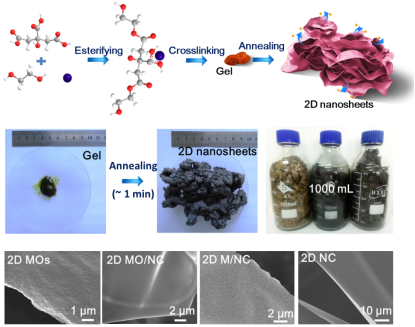Edited by: William Mosteller
Translated by: An Siyuan
Date: September 18th, 2018
HIT News (Weihai campus feeds) With the support of the National Natural Science Foundation and the Taishan Scholars Program, the team of Associate Professor Zhou Weiwei from the School of Materials Science and Engineering at Weihai Campus of HIT has made significant progress in the field of macro-material manufacture of two-dimensional materials. Their research paper with the topic of Mass Production of Large-sized, Nonlayered 2D Nanosheets: Their Directed Synthesis by A Rapid "Gel-Blowing" Strategy, and Applications in Li/Na Storage and Catalysis (large-scale, non-layered two-dimensional nanosheets Production: Synthesis based on gel-expansion strategy and its application in lithium/sodium ion batteries and catalysis) was published in the international top journal Advanced Materials (Impact Factor: 21.95).
In recent years, two-dimensional nanomaterials have attracted a lot of interest from researchers due to their unique physical and structural properties and their potential applications in optoelectronics, FETs, energy conversion and storage. However, the manufacture methods of two-dimensional materials are mainly gas phase method and liquid phase method, but both have certain disadvantages, such as high cost and low yield of chemical vapor deposition method, and it is difficult to obtain large-sized two-dimensional nanosheets by liquid phase method. And subsequent cumbersome purification treatment is required. Furthermore, the above methods are mostly limited to the synthesis of layered two-dimensional materials. Inspired by the traditional Chinese folk art “Blowing Sugar Man”, the research team proposed a new “Gel-Blowing” strategy and synthesized 13 two-dimensional materials including a two-dimensional metal oxide, two-dimensional nitrogen-doped carbon, two-dimensional metal, oxide/nitrogen doped carbon and two-dimensional metal/nitrogen doped carbon. First, a viscous gel similar to "syrup" is obtained by a sol-gel process, and then a large amount of gas generated by rapid heating is used to "blown" the gel into ultra-thin two-dimensional nanosheets, thereby realizing non-layered two-dimensional The material is mass-produced and does not require subsequent purification. The “Gel-Blowing” strategy combines the advantages of gas phase and liquid phase methods. The resulting nanosheets are of high quality and uniform composition with a thickness of up to 2-3 nm and a diameter of up to 100 μm. The method is universal, and more two-dimensional materials can be synthesized by selecting suitable metal precursors and calcination conditions. The obtained two-dimensional nanosheets exhibit excellent performance in the fields of lithium ion batteries, sodium ion batteries, and electrocatalysis. The results of this research have been fully affirmed and highly evaluated by reviewers.
The HIT Weihai Campus is the first unit of this thesis. Associate Professor Zhou Weiwei and Professor Wen Guangwu are the co-authors of this paper. In addition, the team has made progress in the application of metal organic framework materials (MOFs) in the field of energy storage. The relevant results were published in the form of cover articles at the beginning of this year in Journal of Materials A, 2018, 6, 2974 (influence factor: 9.93).

Article Info:Mass Production of Large‐Sized, Nonlayered 2D Nanosheets: Their Directed Synthesis by a Rapid “Gel‐Blowing” Strategy, and Applications in Li/Na Storage and Catalysis (Advanced Materials, 2018, 1803569. DOI: 10.1002/adma.201803569)
Article Link:https://onlinelibrary.wiley.com/doi/full/10.1002/adma.201803569


